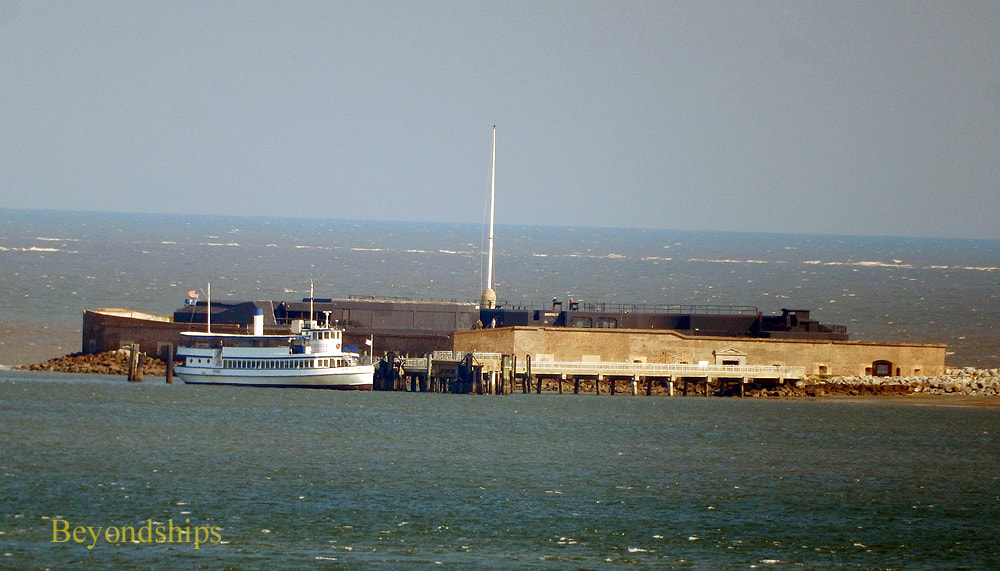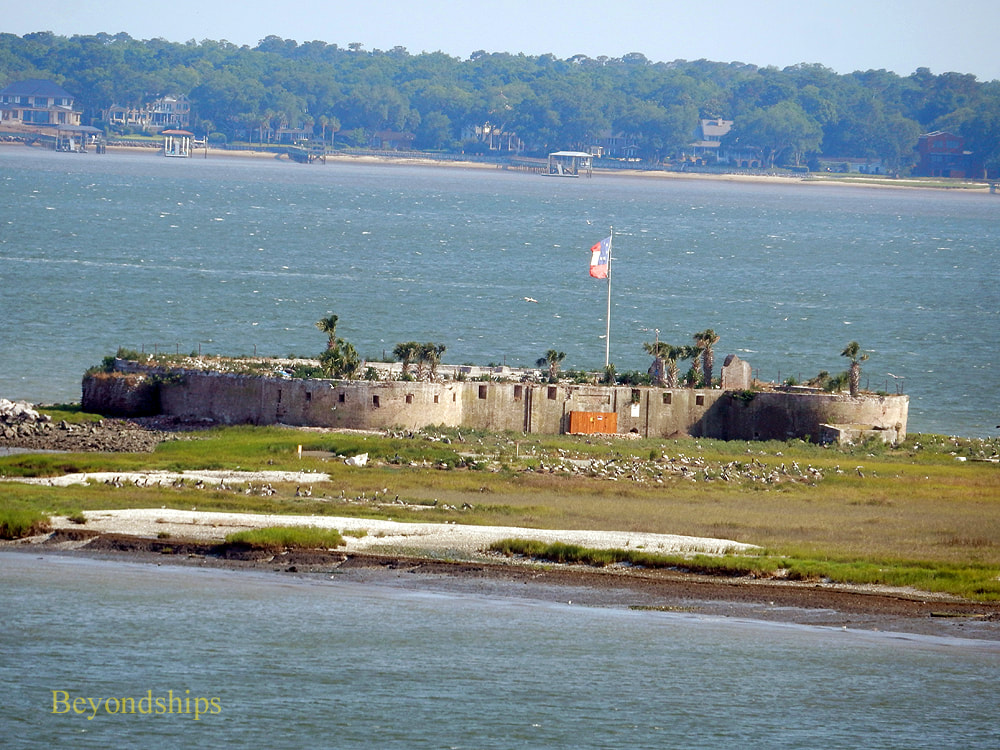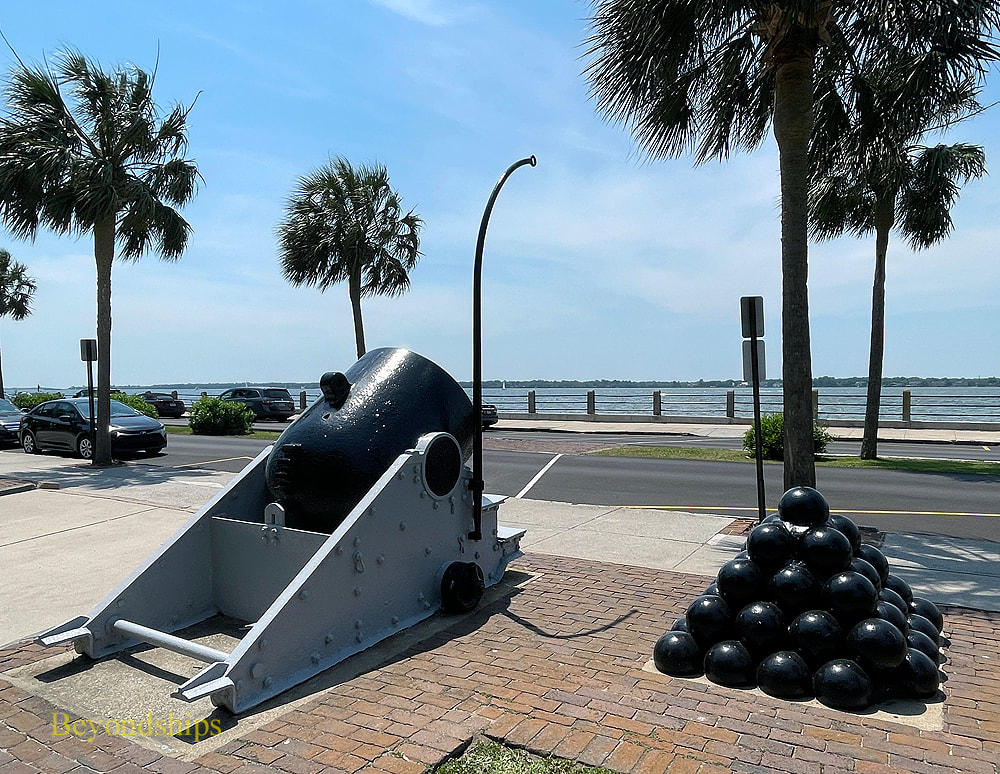ATTRACTIONS
Fort Sumter
|
It is generally agreed that the American Civil War began when rebel troops of the Confederate States of America attacked the United States forces holding Fort Sumter. Located on an artificial island in the channel leading to Charleston harbor, Fort Sumter is today part of the Fort Sumter and Fort Moultre National Park.
Before the Civil War Following the burning of Washington DC by British forces during the War of 1812, the federal government decided that more fortresses were needed to protect America's coastal cities. Inasmuch as Charleston was one of America's most important seaports, the government authorized the building of a new state-of-the-art fortress that would augment the existing fortresses protecting Charleston. Work began on the new fortress in 1829. However, because it was to be built on a sandbar, tons of stone and earth had to be brought in and dumped on the sandbar. Changes in the design of the new fortress also slowed the work. As a result, by 1860, the fortress was only partially complete. In the meantime, controversy over states rights and slavery had reached the boiling point. When Abraham Lincoln was elected President, South Carolina, followed by 10 other states announced that it was seceding from the Union and forming a new country. Built to serve as Charleston's champion, Fort Sumter was now viewed with hostility by those who it had been created to protect. Planned as a five-sided, three-level brick fortress with 150 cannons and a garrison of 650 men, Sumter was little more than a construction site with 15 mounted cannons and 87 soldiers. Although surrounded by armed enemy forces and cut-off from re-supply, the local Union commander, Major John Anderson, rejected Confederate demands that he abandon Fort Sumter. Since the November 1860 election. lame duck President James Buchannan had only made a half-hearted attempt to relieve Fort Sumter. When Lincoln took office in March, he did not immediately take action because he was hoping that some sort of compromise could be reached with the rebels that would avoid war. However, by early April, he decided to risk sending a small flotilla of ships with supplies and 200 reinforcements to Sumter. The Confederates regarded this attempt as a provocation and demanded Sumter's immediate evacuation. They had some 3,000 militia surrounding Sumter. The other forts, which had been abandoned by the federal troops were now manned by Confederates. In addition, they had built batteries on the islands surrounding Sumter. While Anderson's men had managed to mount an additional 45 cannons, they were still out-manned and out-gunned. Nonetheless, Anderson refused to surrender. Shots fired In the early morning hours of April 12, 1861, the Confederates under General P.T. Beauregard, opened fire. What followed was 34 hours of bombardment from several directions. In order to conserve ammunition and powder, the federal guns responded slowly. Furthermore, the defenders did not have fuses for their exploding shells. Thus, while the incoming shells exploded, the outgoing fire was just cannonballs. During the bombardment, the Union relief flotilla appeared within sight of Fort Sumter. However, they elected to remain out of range of the Confederate guns. At 1:30 p.m. on the 13th, Sumter's flag pole was shot away. This prompted a Confederate officer to row out to Sumter from one of the surrounding islands and ask whether Anderson wished to evacuate the fort on the same terms that had been offered before the bombardment began. With the fortress in ruins and low on ammunition, Anderson agreed. Under the agreement, the garrison would leave the fort with their weapons and personal belongings and be given safe conduct out of Charleston. Before they left, the Union troops could give a cannon salute to the Stars and Stripes. Ironically, while no Union soldier had been killed during the bombardment, a solider was killed when a cannon exploded during the salute to the flag. After the Union forces left, the Confederates occupied the fort. They then set about re-building the fort using enslaved people. Sumter once again became the centerpiece of Charleston's seaward defense. |
Attempts to Retake Fort Sumter
In April 1863, Union forces launched a series of attempts to retake Fort Sumter. A large naval flotilla including two ironclad warships and seven monitors attacked Sumter. The attack failed with the loss of one of the ironclads. Union forces returned in September 1863. The plan this time was to make a landing on Sumter and take the fort by storm. There would be a landing by Army soldiers and a landing by sailors and Marines. The Army and Navy commanders, however, viewed each other as rivals and so there was little coordination between the two forces. Intelligence had it that there was only a skeleton garrison of artillery men at Sumter. However, General Beauregard had gotten wind of the planned attack and reinforced the garrison with infantry. Following a bombardment from Union cannons on one of the nearby islands, the Navy force of 400 sailors and Marines landed on Sumter. They found themselves under fierce fire from the defenders and from nearby Fort Johnson as well as from a Confederate warship. The landing force was driven off. Due to problems with the tides, the boats with the Army troops were not able to participate in the action. Sumter remained in Confederate hands until General William T. Sherman's army coming up from the south forced the Confederates to abandon Charleston including Fort Sumter on February 22, 1865. After the Civil War Following the Civil War, the Army set to work to make Fort Sumter a useful military installation once again. The upper levels of the fortress, which had been severely damaged during the war, were removed. New modern artillery was installed in the fort. The Army again modernized Fort Sumter during the Spanish-American War. This included installing two massive 12-inch guns in a concrete bunker in 1898. This battery never saw action but remained active through both World Wars, only being deactivated in 1947. Visiting Fort Sumter In 1948, Fort Sumter was taken over by the National Park Service. Today's Fort Sumter and Fort Moultre National Park includes three sites. The Fort Sumter Education Centre in Charleston's Liberty Square includes museum exhibits concerning the Civil War era. The Fort Moultre Visitor Centre is on Sullivan Island and includes museum exhibits and an information desk. Fort Sumter includes the remains of the fortress and a museum. Fort Sumter is a long distance from downtown Charleston. From the Battery in Charleston's Historic District, you can see little more than the fort's tall flagpole. However, cruise ships calling in Charleston pass close by Fort Sumter. The only way to get to Fort Sumter is by tour boat. The boats leave from two locations - - Liberty Square and Patriots' Point. Private vessels are not allowed to dock at the Fort's pier. For more information on visiting, see the National Park Service website. Above: Close by the shore of Charleston's historic district are the remains of another of the forts that once defended Charleston, Castle Pinckney.
Below: A civil war era mortar in The Battery in Charleston's Historic District. |
|
|
For more about cruising to Charleston
Click here for our Charleston cruise port page Click here for our Charleston home page |
|
|
|
Cruise destination - Charleston, South Carolina, United States - Charleston Attractions - page 2 - Fort Sumter


